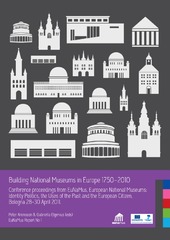Prikaz osnovnih podataka o dokumentu
National Museums in Serbia: A Story of Intertwined Identities
| dc.contributor | Aronsson, Peter | |
| dc.contributor | Elgenius, Gabriella | |
| dc.creator | Ignjatović, Aleksandar | |
| dc.creator | Manojlović Pintar, Olga | |
| dc.date.accessioned | 2020-06-09T13:08:02Z | |
| dc.date.available | 2020-06-09T13:08:02Z | |
| dc.date.issued | 2011 | |
| dc.identifier.uri | https://raf.arh.bg.ac.rs/handle/123456789/828 | |
| dc.description.abstract | In our paper, we are analyzing five museums as the comparative objects of research aimed at exploring the processes of identity- and state-building in Serbia over the course of the last two centuries. These museums are: the National Museum, the Museum of Contemporary Art, the Museum of Yugoslav History, the Museum of African Art, and the Museum of the Victims of Genocide. We defined these museums in terms of the official interpretational discourses and the roles they perform in society both in synchronic and diachronic terms — the latter in particular often being expressed by a range of meanings and functions. These museums have been chosen for closer examination because they represent rather paradigmatic examples of both the institutions and narrative-producers, within the process of identity and state building in Serbia, which have been developed over the course of last two centuries. We analyzed the periods of nineteenth century nation-state building, as well as the twentieth century formation of Yugoslavia and the construction of socialism. Special attention, however, was put on contemporary Serbian society and the relationships between the museum protagonists and museum narratives. Surely, an integral part of the research includes a number of changes and transitions within museum policies and narratives, along with hidden, ‘deaf’ historical events or cultural phenomena that have not been represented in Serbian museums so far. The main analytical points and conclusions of the research are: the national museums in Serbia have played important roles within the complexity of representational discourse, which included the nation-building processes. Museum practices constructed national identity as a multifaceted entity, being based on a variety of perspectives: historical, archaeological, ethnological, anthropological, artistic and geographical. However, the museums have produced changeable visions of collective identity, mainly as a result of ideological and political context. Yet museum practices have not merely reflected certain ideological frameworks and political realities, but rather represented constitutive elements of ideological and political context. Secondly, our analysis is based on a wider understanding of the term ‘national museum’ and the explanation of the museum network in Serbia, as a complex, interdependent system of policies and narratives, which have a crucial role in the process of identity-building in Serbia. The network has been structured according to the simultaneity of several metanarratives: revolution, state-building, modernization/Europeanization, national authenticity/indigenousness, etc. Finally, our analysis shows that museum policies and narratives have been based on three general paradigms related to nation- and state-construction processes, each of them being heavily dependent upon interpretational discourse and firmly anchored to ideological and political context. The first one is the paradigm of exceptionalism and uniqueness; the second is the one that supports a rather mediatory concept of national identity, and the third paradigm establishes new interpretations of different historical processes. | en |
| dc.language.iso | en | sr |
| dc.publisher | Linköping: Linköping University Press | sr |
| dc.relation | EUNAMUS Project: European national museums: Identity politics, the uses of the past and the European citizen. EU FP Grant Agreement, Seventh Framework Programme | sr |
| dc.rights | openAccess | sr |
| dc.source | Building national museums in Europe 1750-2010 : conference proceedings from EuNaMus, European National Museums: Identity Politics, the Uses of the Past and the European Citizen, Bologna 28-30 April 2011 | sr |
| dc.subject | National museums | sr |
| dc.subject | European museums | sr |
| dc.subject | National identity | sr |
| dc.subject | Nationalism | sr |
| dc.subject | Comparative history | sr |
| dc.title | National Museums in Serbia: A Story of Intertwined Identities | en |
| dc.type | conferenceObject | sr |
| dc.rights.license | ARR | sr |
| dcterms.abstract | Манојловић Пинтар, Олга; Игњатовић, Aлександар; | |
| dc.citation.spage | 779 | |
| dc.citation.epage | 815 | |
| dc.identifier.fulltext | https://raf.arh.bg.ac.rs/bitstream/id/2356/bitstream_2356.pdf | |
| dc.identifier.rcub | https://hdl.handle.net/21.15107/rcub_raf_828 | |
| dc.type.version | publishedVersion | sr |

